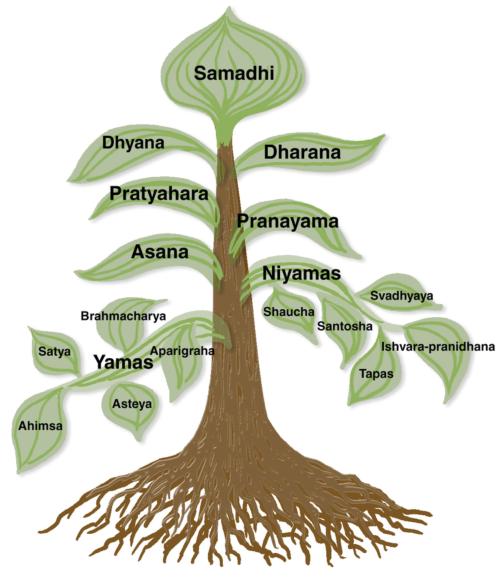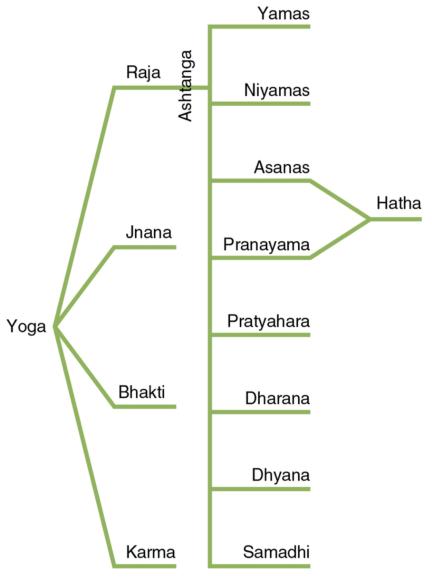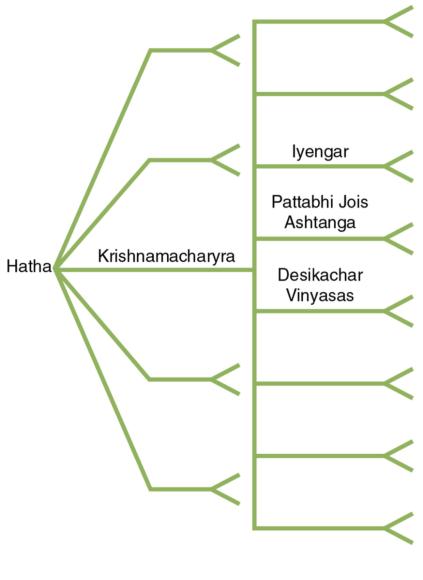The four primary types of yoga
This is an excerpt from Instructing Hatha Yoga 2nd Edition With Web Resource by Diane M Ambrosini.
Types of Yoga
There are as many ways to practice yoga as there are to unite with bliss and enlightenment. Essentially, however, current practice involves four primary types of yoga: karma, bhakti, jnana, and raja.
- Karma [KAR-muh] yoga isthe path of service through selfless action for the good of others - for example, Mother Teresa's works to serve poor people as a way to connect the compassion of God with humanity. Unconditional service is a tradition in Hindu monasteries or ashrams [AAHSH-ruhms], and many yoga teacher training programs require candidates to practice karma yoga by cooking and cleaning or providing other voluntary service for others.
- Bhakti [b-HUHK-tee]yoga cultivates the expression and love of the Divine through devotional rituals. Forms of this path include regular prayer, chanting, singing, dancing, ceremony, and celebration. For example, bhakti yoga is practiced and shared in the uplifting music of renowned kirtan (devotional chant) vocalist and spiritual leader Krishna Das.
- Jnana [YAAH-nuh]yoga isthe path of intellect and wisdom, and its components include study of sacred texts, intellectual debates, philosophical discussion, and introspection. Socrates was a jnana yogi, as are modern-day yoga scholars such as David Frawley and Ravi Ravindra.
- Raja [RAAH-juh]yoga, also known as the "royal path," refers to the journey toward personal enlightenment. This path consists of balancing the three main yoga types just described - karma, bhakti, and jnana - while integrating the eight limbs, or stages, of yoga (for further discussion, see the sidebar titled The Eight Limbs of the Royal Path). Hatha [HUH-tuh] yoga is represented as a combination of the third and fourth limbs of the royal path - that is, asana [AAH-suh-nuh]and pranayama [praah-naah-YAAH-muh] (see figure 1.1 and the sidebar about the eight limbs).

The tree of yoga.
Hatha yoga is the type generally practiced in modern (and especially Western) society. The word hatha is usually translated from Sanskrit as "sun and moon," with ha signifying sun energy and tha signifying moon energy. Balancing the active ha energy and the more calming tha energy is the ultimate aim of hatha yoga practice. Hatha is also translated as "forceful" (see figure 1.2), and this translationis included in the Hatha Yoga Pradipika [praah-DEE-PEE-kuh] - a classic text used by those who study hatha yoga. Some practitioners have expounded that this translation is appropriate because hatha yoga requires great physical effort. On a symbolic as well as a physical level, then, hatha refers to a balancing of energies or forces.

Yoga lineage.
The Eight Limbs of the Royal Path
Think of the eight limbs of yoga as parts of the great tree of yoga. Each limb connects to the trunk, and yoga is grounded and nurtured by its deep, ancient roots. Each limb has leaves that express the life of the limb; these leaves are the techniques of the yogic limbs. The eight limbs, or stages, of yoga are outlined in the text of the Yoga Sutras, which was compiled and writtenaround 300 to 200 BCE by the sage Patanjali [pa-TAHN-jah-lee].
Limb 1
Yamas [YAAH-muhs] - guidelines for ethical standards and moral conduct
- Ahimsa [uh-HEEM-saah] - nonviolence
- Satya [SUHT-yuh] - truthfulness
- Asteya [uh-STAY-uh] - nonstealing
- Brahmacharya [bruh-muh-CAHR-yuh] - moderation
- Aparigraha [uh-PUH-reeg-ruh-huh] - nonattachment
Limb 2
Niyamas [nee-YUH-muhs] - observances and disciplines
- Saucha [SHOWH-chuh] - cleanliness
- Santosha [suhn-TOH-shuh] - contentment
- Tapas [TUH-puhs] - austerities (translated as "heat" or "purifying practices")
- Svadhyaya [svaahd-HYAAH-yuh] - study of spiritual scriptures
- Ishvara pranidhana [EEHSH-vuh-ruh pruh-need-HAAH-nuh] - practice of awareness and surrender to the presence and divine will of God
Limb 3
Asana [AAH-suh-nuh] - practice of physical postures
Pranayama [praah-naah-YAAH-muh] - special breathing techniques used to control the life force, or energy, in the body
Limb 5
Pratyahara [pruht-yaah-HAAH-ruh] - withdrawal of the senses as part of the transcendence of constant nervous stimuli; practice of sensory detachment through deep relaxation techniques
Limb 6
Dharana [dhaahr-UHN-aah] - concentration and focus
Limb 7
Dhyana [dhahy-AAH-nuh] - meditation
Limb 8
Samadhi [suh-MAAHD-hee] - state of ecstasy, bliss, and enlightenment that transcends the Self and merges with the Divine
Types of Hatha Yoga
Hatha yoga focuses on the path toward personal wellness and enlightenment through physical, mental, and spiritual means. The category of hatha yoga encompasses a number of popular styles of practice. Most hatha classes are generic in style, which means thatthey blend popular elements of various styles that stand alone as specific forms. Two of the best-known styles of hatha are Iyengar and Ashtanga, and classical-eclectic hatha classes often include traits of either or both of these styles. As a result, many students are confused into thinking that hatha yoga is a style in and of itself, apart from any other named style, when in fact it is the umbrella under which all hatha styles fall.
Although approaches to hatha yoga differ from each other, all of these methods are meant to help practitioners achieve the goals of greater health and general well-being through deeper self-awareness. With this end in mind, this text presents an overall picture of the physical discipline while also bridging the gaps between East and West, ancient and progressive, physical and spiritual, science and art, flexibility and strength, and student and teacher. Yoga is not associated with rebellion or revolution; instead, it is a practical response to the hectic nature of our modern lives, which likely provides the impetus for the tidal wave of interest in yoga throughout the world.
The general practice of hatha yoga strives to be progressive while maintaining a basic connection to traditional teachings. Over the millennia, considerable changes have occurred - in practice venues, students, and teachers - and such changes are likely to continue. Yet even as forms and styles branch out and evolve, they continue to derive from the same basic roots. In fact, the founders of two of the most popular styles of modern hatha yoga, Iyengar and Ashtanga, had the same teacher - Sri Tirumalai Krishnamacharya(see figure 1.3).

Hatha yoga lineage. The blank lines represent other lineages.
Iyengar Yoga
In the early twentieth century, world-renowned yoga master B.K.S. Iyengar created a style of hatha yoga focused primarily on achieving precise physical alignment during the execution of poses. At times, especially in the 1970s and 1980s, Mr. Iyengar was likened to a drill sergeant because his teaching style was somewhat strict in its extreme attention to physical positioning. To assist in this positioning, Iyengar yoga students use many types of props, which enable people at all levels of proficiency to go deeper or stay longer in postures with more accurate physical alignment.
Props are becoming more common in classical-eclecticclasses as well, but Mr. Iyengar was an innovator in hatha practice because of his insistence on precision with props and his demand that his yoga students be consciously focused in the mind and obediently energetic in the body. As a result, Iyengar teacher trainings can take three or more years to complete, depending upon which level of certification a candidate is interested in reaching with their training; Iyengar has three basic levels of training.
Iyengar yoga places so much emphasis on physical alignment, as Mr. Iyengar believed that it takes most people most of their lives to get the body into its most appropriate physical alignment, that Surya Namaskaras (Sun Salutations) are not performed and pranayama (breath work) is abandoned in the asana classes until students are proficient in their alignment practices. However, certain pranayamas are taught in workshops or as a separate practice altogether. Iyengar yoga also prohibits music and partner work because they are thought to be distractions. Although some find this hatha style to be intimidating, it is generally the safest form of physical practice because of its diligent attention to body alignment.
Even so, many people are uncomfortable with this style because instructors generally do not allow students to go as deeply into a posture as they might like. Instead, instructors insist that students use props and move only as far into a posture as they are able to manage while maintaining the most optimal alignment possible. Given this focus, Iyengar classes disallow baggy clothes because they hide so much of a student's body that the instructor might miss a detail needing adjustment. Of course, each teacher conducts class in her or his own way, but true-blue Iyengar instructors tend to be strict in their teaching styles in order to adhere to Iyengar's exacting guidelines.
Ashtanga Yoga and Power Yoga
Ashtanga means "eight limbs"; in contemporary hatha circles, it also refers to a style of yoga practice introduced by Pattabhi Jois. This dynamic form of hatha yoga involves vigorous flow from posture to posture. More specifically, Ashtanga practice today involves six series, or set combinations of postures, in which practitioners move from one posture to the next without stopping. Generally, however, only the primary (yoga chikitsa) series and the second (intermediate, or nadi shodhana) series are taught in class settings because the remaining four series are quite physically demanding. In fact, those four can be practiced only by persons who have spent considerable time learning and accomplishing them.
Ashtanga yoga was rediscovered in the twentieth century when Pattabhi Jois and his teacher, Sri Krishnamacharya, translated a practice they found outlined in an ancient text called the Yoga Korunta. Krishnamacharya found the manuscript written on leaves in a form of Sanskrit used 5,000 years ago; according to interpreters, the estimated date of its transcription is at least 1,500 years ago. Pattabhi Jois named the practice Ashtanga, based on the second Pada (or chapter) of Patanjali's Yoga Sutras. In the pada, the term ashta-anga (eight limbs) are outlined and the Pattabhi Jois believed the integration of the eight limbs were steps to gradually awaken to Samadhi (Divine Consciousness).
Because many people either did not recognize the term Ashtanga or misunderstood it as referring to raja yoga, the practice was referred to for some time by the term power yoga. In the 1990s, Beryl Bender Birch wrote a book called Power Yoga that demystified the practice of Ashtanga for many, and the book still serves as a great reference on the benefits of this style. Unfortunately, however, some confusion persists about Ashtanga and power yoga. Ashtanga is the practice of a set series of postures. In contrast, power yoga classes are generally hybrids that use some of the postures and flow of Ashtanga but are often not true to Ashtanga sequencing. The practice of power yoga continues to be brought alive by innovative modern yoga teachers, such as Baron Baptiste and Bryan Kest.
In this book, the term Ashtanga refers to the dynamic series of postures rediscovered by Pattabhi Jois and Sri Krishnamacharya. Many Ashtanga classes use abridged versions of these original series because a hatha class is often only one hour long and the students are often of mixed ability.
In practicing either Ashtanga or Iyengar yoga, one sees (and feels!) both the physical and the mental distinctiveness of the chosen style. At the same time, the two approaches share common ground since their founders - Pattabhi Jois and B.K.S. Iyengar, respectively - are contemporaries who had the same mentor in Sri Krishnamacharya. In fact, at first glance, it may seem surprising that two such different styles could be traced back only one generation to the same root. However, Sri Krishnamacharya was known to teach each student according to his or her personal needs. Table 1.1 illustrates the differences between these two styles of hatha yoga in mental focus and physical components.

Vinyasa Yoga
Another style of hatha yoga involves the practice of linking Surya Namaskaras (Sun Salutations) or similar postures between poses. Practitioners repeat each pose in the sequence before going on to the next one; after adding each new pose, they do a vinyasa [vin-YAAH-suh] - a flowing movement linked with the breath. Most vinyasa teachers use variations of poses and sequencing to create a smooth flow from pose to pose rather than simply stopping one posture and starting again. The word vinyasa refers to the flowing or linking of poses in synchronization with the breath.
Variations of Sun Salutations are the vinyasas that link other poses together in Ashtanga yoga. However, vinyasas do not have to be vigorous; in fact, they can be slow and gentle as one pose flows easily and softly into another, similar pose. The key is to connect poses with the breath.
Viniyoga
Not to be confused with vinyasa yoga, viniyoga is another method of hatha yoga linked to Sri Tirumalai Krishnamacharya. His son, T.K.V. Desikachar, used a style of classical-eclectic hatha that directly applies the physical practices of yoga as a purely therapeutic modality based on an individual's specific needs. The style is referred to as viniyoga,meaning "applied yoga," by Western students of Desikachar, including Mark Whitwell and American Viniyoga Institute founder Gary Kraftsow.
Viniyoga emphasizes using the breath as a means to achieve specific outcomes, either with or without accompanying movement. When asanas are practiced as part of therapy, they are often repeated and are linked directly to functionality. This style uses the ancient practices of yoga for physical, emotional, and spiritual healing. Classes are often taught one on one or in small groups so that the teacher can address each student's individual needs.
Bikram and Hot Yoga
Once known mainly as the "yoga of the stars," the Bikram style of hatha has spread from Beverly Hills throughout the United States since the late 1970s. The Bikram style is the original "hot yoga" style, and its classes are taught in a room kept at approximately 106 degrees Fahrenheit (41 degrees Celsius). Bikram yoga is based on one series consisting of 26 poses, which are practiced twice in a class session.
Though this style of yoga is purported to have originated with its namesake, Bikram Choudhury, it can be traced back to Bishnu Ghosh, the brother of Paramahansa Yogananda, who founded the Self-Realization Fellowship in 1925. Mr. Choudhury insists that, barring any physical limitations, newcomers participate in class every day for two months before easing into the regimen. He believes that this intensity serves as an incentive and as an initiation into the style, which promises a better body and new life through a detoxifying practice that some liken to a yoga boot camp. Many Bikram-trained teachers have migrated away from teaching Mr. Choudhury's particular style of hatha yoga due to trademark and copyright disputes as well as allegations of his misconduct. Instead, they teach their own version of heated yoga.
Many Bikram yoga studios are now built from the ground up and include state-of-the-art heating systems to maintain the desired room temperature for classes. Scores of students revel in the feeling of looseness that they attain in the penetrating heat; at the same time, many people are leery about the intense temperature used in these styles. Indeed, the room's high temperature is enhanced by the mass of body heat exuding relentlessly from class participants as they practice one posture after another. In contrast, in Ashtanga hatha, the heat is created solely by the practitioner's own body moving through linked poses via vigorous vinyasas.
For some people, the high temperature is overwhelming; for many others, however, the effect of performing the asanas in a sauna-like environment is what gets them hooked. Indeed, sweating can be therapeutic and cleansing. Still, these yoga styles are not for everyone.
People with potentially complicating conditions should be very mindful when considering whether to practice in the heat - for example, deconditioned students who have a tendency toward high blood pressure or whose core body temperature tends to run high. In addition, some people simply do not tolerate heat as well as others, and these people need to allow themselves rest periods and water breaks when they attend a class, especially when the heat is extreme.
Learn more about Instructing Hatha Yoga, Second Edition.
More Excerpts From Instructing Hatha Yoga 2nd Edition With Web ResourceSHOP

Get the latest insights with regular newsletters, plus periodic product information and special insider offers.
JOIN NOW


